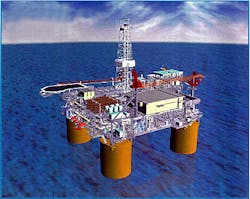Depicted is an artist's rendering of how the Brutus tension-leg platform would look. Image courtesy of Shell Deepwater Development Systems Inc.Shell Exploration & Production Co., Houston, has marked a pair of milestones in the deepwater Gulf of Mexico.
Shell last week unveiled plans to move ahead with the $900 million development of its Brutus oil and gas discovery in the deepwater gulf's Green Canyon area.
Also last week, Shell claimed a water-depth record for an oil and gas production platform with the start of production from its Ursa tension-leg platform (TLP) in about 3,800 ft of water.
Brutus's development
Brutus field covers Green Canyon Blocks 158 and 202, which Shell acquired 100% in a federal lease sale in March 1985 for $15.5 million.Brutus is Shell's fifth TLP in the Gulf of Mexico and will be the 17th deepwater project in the gulf in which Shell is involved. Brutus, about 165 miles southwest of New Orleans, will be developed with a TLP in 2,985 ft of water.
Shell drilled the Brutus discovery well on Block 158 in December 1988. An appraisal well followed in 1994 on the same block; in 1997, a third well was drilled.
Shell is focusing on Plio-Pleistocene sands reserves at about 12,500-17,500 ft.
Installation of the eight-slot TLP, which will serve as a hub for any future subsea projects to be developed by Shell in the area, is slated for mid-2001. Production is expected to start in late 2001, reaching a peak capacity of about 100,000 b/d of oil and 150 MMcfd of gas.
Gross recovery of Brutus reserves is estimated at more than 200 million boe with a 70:30 oil-to-gas ratio.
Brutus will have complete separation, dehydration, and treatment facilities. These facilities will be capable of processing 100,000 b/d of oil and condensate, 300 MMcfd of gas, and 30,000 b/d of produced water.
Oil and gas will be transported from Brutus via pipeline. Construction on these lines is slated for 2000. Oil production will be shipped through an 18-in. line 26 miles to South Timbalier 301 B platform. From there, it will flow through the existing Amberjack system. Equilon Pipeline Co. LLC will own and operate the line.
Gas production will be transported through an 18-in., 24-mile system that will be linked with the existing Manta Ray offshore gathering system. The gas pipeline will be owned and operated by Tejas Energy LLC unit Tejas Offshore Pipelines.
Brutus's design
Brutus will have a design comparable to Ram-Powell and Mars TLPs-two other Shell deepwater gulf platforms. Shell Deepwater Development Systems Inc. will design and engineer the TLP (see artist's rendering). Once installed, Brutus will stand 3,250 ft tall from seabed to drilling rig crown block.Four 166-ft circular steel columns will comprise the TLP's hull. Each column will weigh about 13,500 tons, be 66.5 ft in diameter, and displace 54,700 tons.
The pontoons that connect the columns will be 23 ft high and 35.5 ft wide. Twelve 2,900-ft tendons will be attached to twelve 340-ft piles of the TLP's foundation system. Each corner of Brutus will have three tendons.
Brutus's deck will have five modules-processing, drilling, power, quarters, and wellbay. The outside truss rows of the deck will be 245 sq ft and 40 ft tall. The deck, with an open truss frame design, will weigh 7,650 tons. Including the processing equipment and the drilling rig, the topsides will have a total weight of 22,000 tons.
Ursa production
Production began Mar. 8 from the Ursa TLP, 4 months ahead of schedule.Ursa is on Mississippi Canyon Block 809. About 130 miles southeast of New Orleans (see map, OGJ, May 27, 1996, p. 24), Ursa has reached a production rate of 13,000 b/d of oil and 20 MMcfd of gas from its first well. Design production rates are 150,000 b/d of oil and 400 MMcfd of gas.
The water depth for Ursa bests the previous record for a permanent oil and gas production platform set by the Ram-Powell TLP in 3,214 ft of water in 1997. Total project cost is about $1.45 billion, excluding lease costs.
Ursa partners-Shell, BP Amoco plc, Conoco Inc., and Exxon Corp.-estimate the field's reserves at 400 million boe. Interests are operator Shell 45%, BP Amoco 23%, and Conoco and Exxon 16% each.
Copyright 1999 Oil & Gas Journal. All Rights Reserved.


